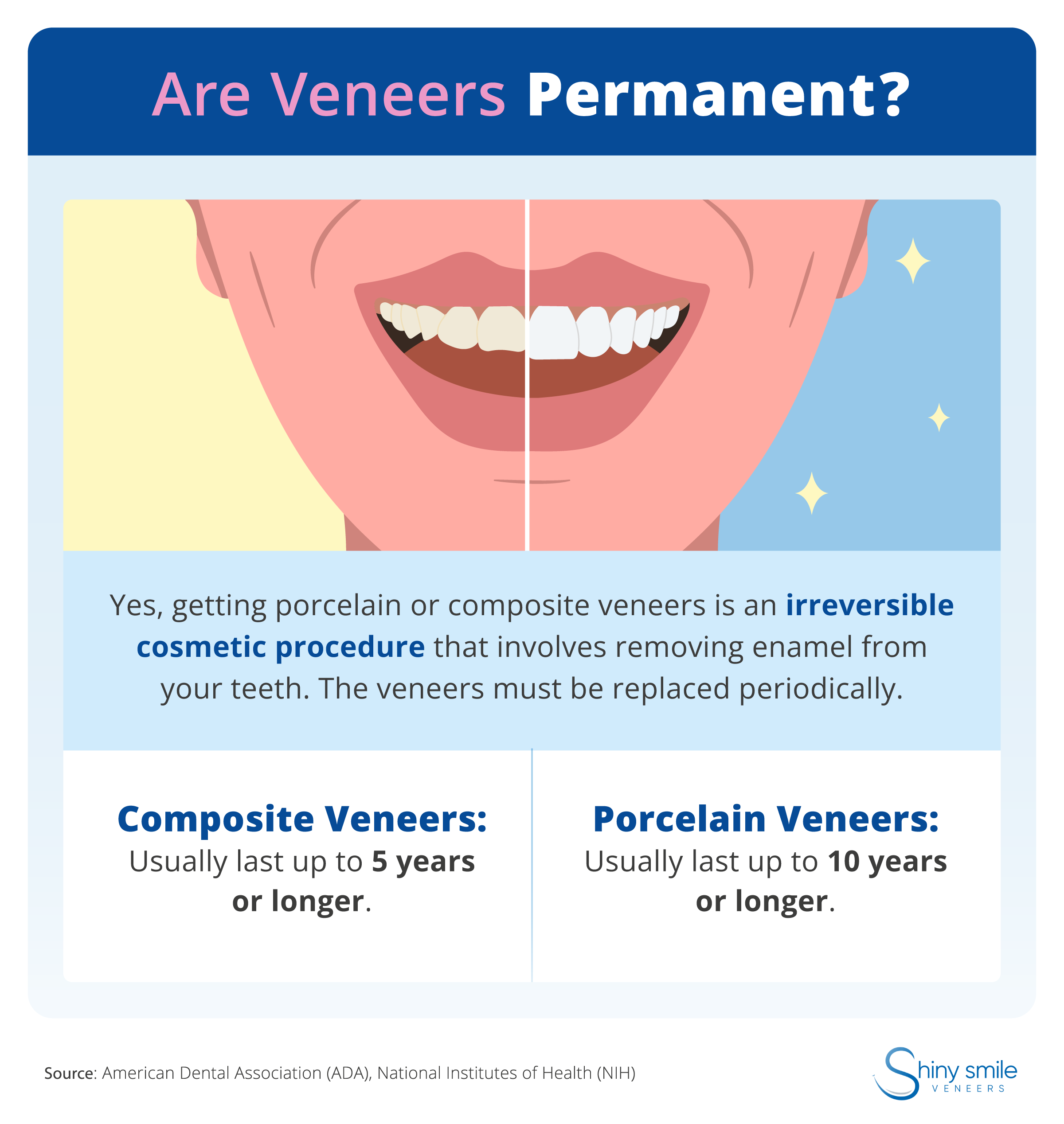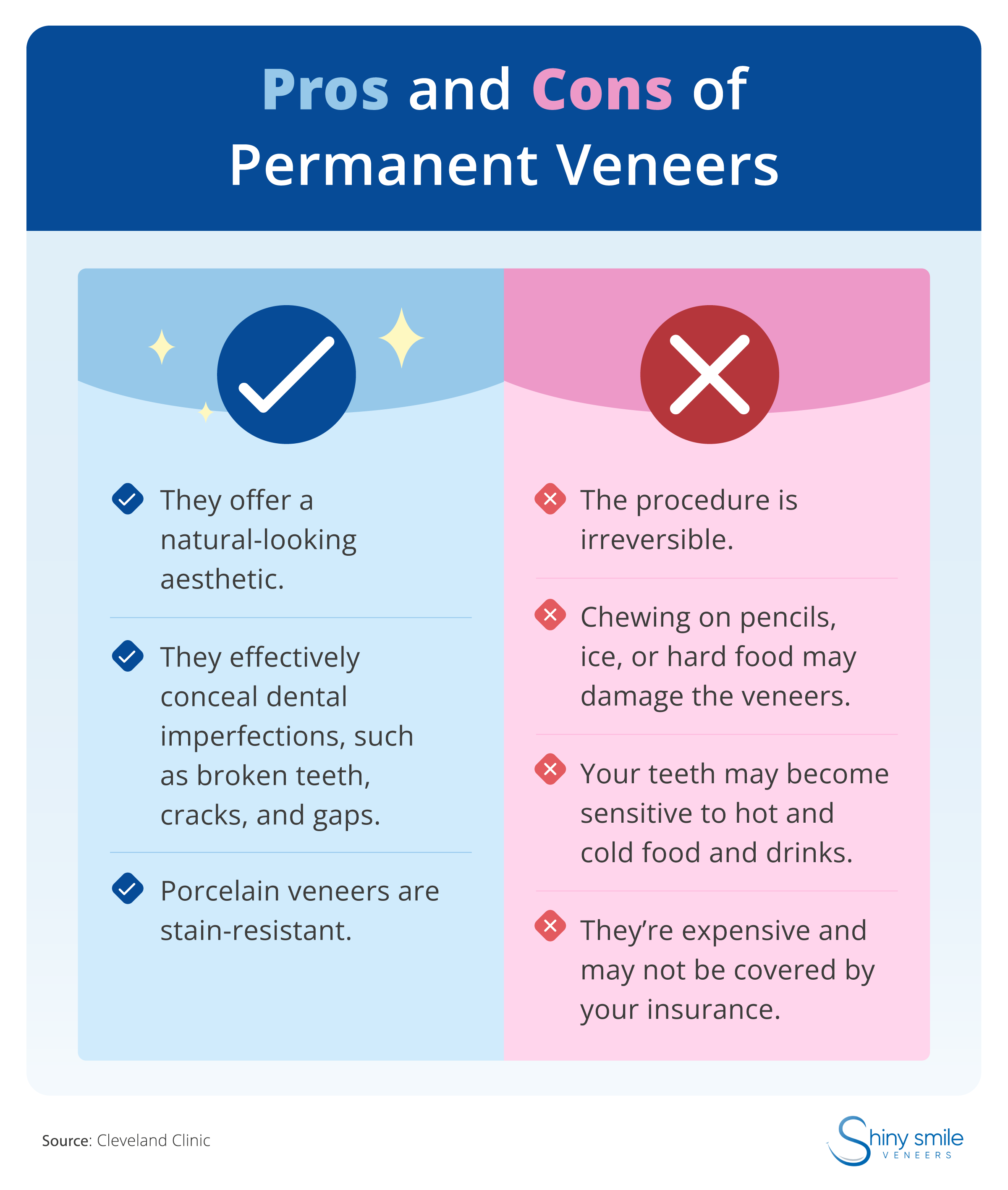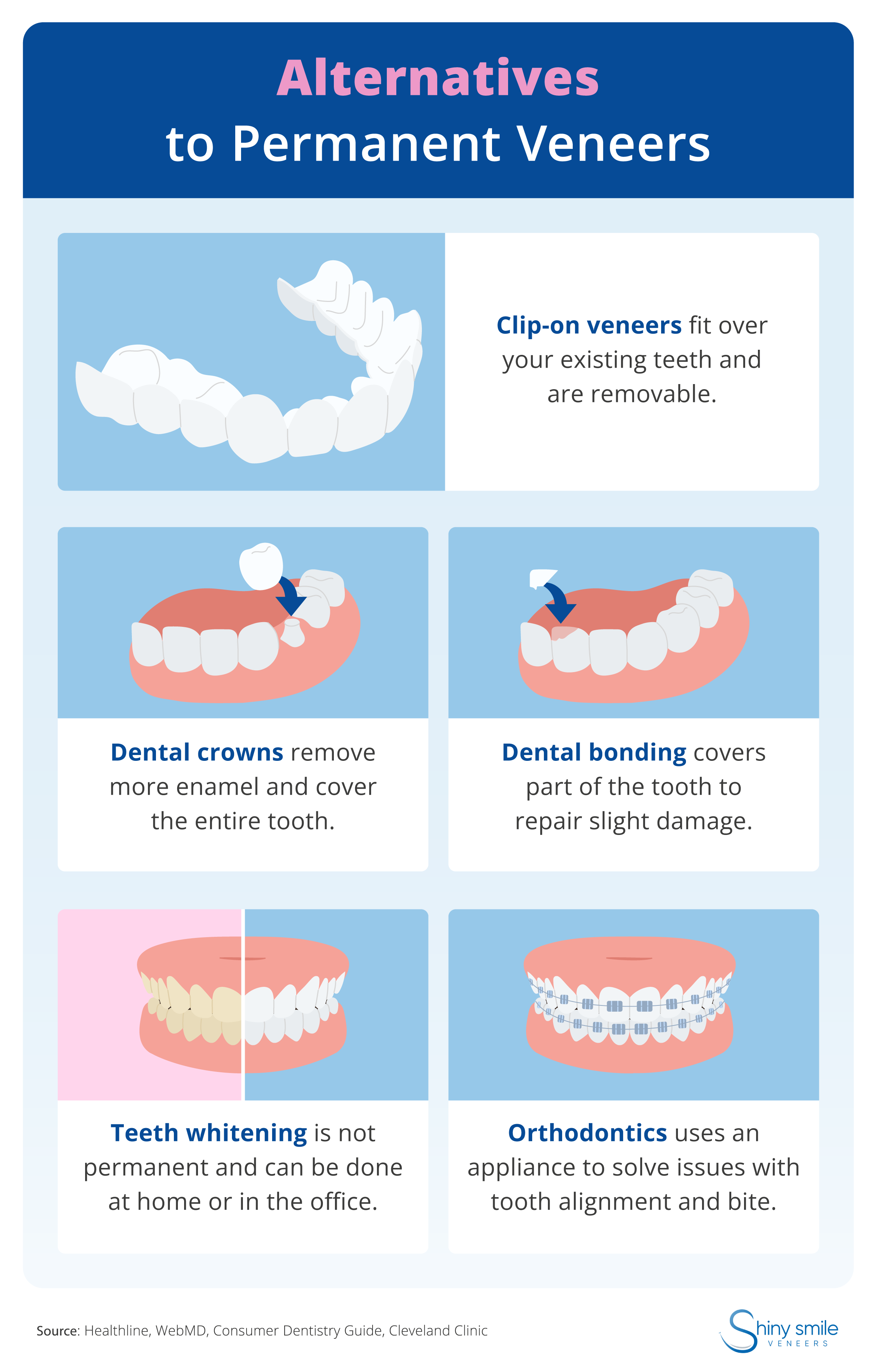
Getting traditional porcelain or composite dental veneers is a permanent cosmetic procedure that involves removing enamel from your teeth in order to fit tooth-colored shells. While the veneer process is irreversible, the shells themselves may need to be replaced every 5 to 20 years depending on the material and method used. Because the procedure is not reversible, you should think carefully before committing to traditional porcelain or composite veneers.
This post explains the different types of traditional veneers, how they’re fitted, the pros and cons of this treatment, and alternatives like clip-on veneers to correct the appearance of your teeth.
Table of Contents
- Is getting veneers a permanent procedure?
- How long do veneers typically last?
- What are the different types of veneers?
- Benefits and risks of getting veneers
- 4 alternatives to veneers
- Restore your smile
Is Getting Veneers a Permanent Procedure?
Bonded to the front of your teeth, veneers are thin shells made of tooth-colored materials such as porcelain or composite resin. Because they look like your natural teeth, veneers are designed to correct the appearance of stained, chipped, decayed, or crooked teeth.

Placing traditional veneers involves grinding the tooth down and removing some of the enamel and in some cases, past the enamel. This procedure is irreversible, can be painful, and often requires local anesthetic. Unlike traditional veneers, clip-on veneers are temporary and can be removed.
How Long Do Veneers Typically Last?
How long veneers last depends on the material and the method used during the treatment. Over time, you may need to have veneers replaced due to factors like discoloration, natural wear, or fractures.
- Porcelain veneers typically last up to 10 years, and in some cases even 20.
- Composite veneers have less durability, with a lifespan of up to five years or longer.
- Clip-on veneers can last up to five years or longer depending on how often you wear them. No special dental care is required for veneers other than good oral hygiene and normal dental checkups.
What Are the Types of Traditional Veneers?
Traditional veneers come in a variety of materials, involve different preparation procedures, and last for varying amounts of time. Below we discuss two common veneer materials.
Porcelain Veneers
Porcelain veneers typically offer a natural-looking aesthetic because the material has a translucency similar to that of natural tooth enamel. Porcelain veneers are strong, long-lasting, resistant to chipping and wear, and often make the better option for more severe treatment situations such as worn enamel, uneven teeth, spacing issues, and so on.
The porcelain veneer procedure involves irreversibly shaping your natural teeth to fit the shell. It can be time-consuming, as your dentist will create a mold of your mouth and send it to a laboratory for fabrication. In the end, the entire process may end up taking a lot of time and costing between $925 and $2,500 per tooth. While expensive, porcelain veneers typically last between 10 and 20 years.
Composite Veneers
Composite veneers use a tooth-colored resin that is sculpted onto your teeth and then hardened using a high-intensity light, typically making it a one-day treatment. If less enamel is removed, your natural teeth may be less permanently altered than during the porcelain veneer process. With resin veneers, your dentist can remove and replace the material if needed.
On the downside, the porosity of composite veneers makes them more susceptible to staining, and less suitable for more severe dental treatments. They also tend to be less durable, with studies showing that composite veneers typically last up to five years. However, resin veneers also tend to cost less, with a price range of around $250 to $1,500 per tooth.
Benefits and Risks of Getting Veneers
Traditional veneers can give you a brand new smile, but they also come with potential drawbacks. Below we cover both the pros and cons of veneers.

Benefits of Veneers
The advantages of permanent veneers include the following:
- They look like real teeth so people likely won’t notice you have them.
- They fix a variety of dental imperfections, such as cracked or chipped teeth, large gaps, and permanent discoloration.
- Porcelain veneers are stain-resistant and should stay white for their lifetime.
Risks of Veneers
Traditional veneers involve cosmetic dentistry procedures that have potential downsides as well:
- The process is irreversible so you can’t change your mind after having it done.
- Patients who clench or grind their teeth may not be the best candidates for veneers because these habits can cause wear and tear. Biting your nails and chewing on pencils or hard foods may also cause the veneers to dislodge or fall off.
- Because your dentist will remove some enamel to place the thin shells, your teeth may be more sensitive to hot and cold food and drinks.
- Veneers are typically expensive and may not be covered by insurance as the procedure is cosmetic.
5 Alternatives to Permanent Veneers
If you have concerns about the price, irreversibility, or risks of permanent veneers, you may consider the following alternatives to traditional veneers.

Clip-on Veneers
Like traditional veneers, clip-on veneers mask imperfections in your teeth to give you a beautiful smile. Unlike traditional veneers, however, clip-ons are temporary veneers that you can wear and remove as often as you like.
- Process: Clip-on veneers fit over your existing teeth much like a mouth guard. You take an impression of your teeth yourself using a kit, send it back, and receive clip-on veneers customized to your teeth.
- Cost: Clip-ons are less expensive than permanent veneers, with Shiny Smile Veneers costing $570.
- Longevity: Clip-on veneers last up to five years with normal wear and can last longer depending on how often you wear them. No enamel is removed from your teeth, so you can remove them at any time.
- Is professional treatment required? No — you can do the process at home, without needing to visit a dentist or undergo an uncomfortable dental treatment.
Dental Crowns
Another smile-restoration alternative to traditional veneers are dental crowns. Whereas traditional veneers only cover the front of your teeth, dental crowns cover the entire tooth.
- Process: Crowns fit completely over your teeth, so even more of the tooth needs to be ground down for the crown to be placed than for traditional veneers. Crowns are typically made of porcelain, porcelain fused to a metal alloy, or an all-metal alloy.
- Cost: This dental procedure costs $1,000 to $3,500 per tooth, depending on the material used, size of the tooth, and prep work required.
- Longevity: Dental crowns last 10 to 15 years on average, depending on the material used and your oral health habits (including regular brushing and flossing).
- Is professional treatment required? Yes — you’ll need to have the impression of your tooth taken, and again to have the crown fitted.
Dental Bonding
In dental bonding, your dentist roughens the tooth surface and applies a tooth-colored resin. The material hardens under a bright light and then is shaped and polished to match the rest of the surface. Although it’s often a low- or no-prep procedure, most dentists consider it best for short-term correction of small cosmetic issues.
- Process: Dental bonding uses a similar process to composite veneers but only covers part of the tooth rather than the entire surface. Dentists often perform this procedure to repair tooth decay or cracks.
- Cost: Dental bonding usually costs around $100 to $400 per tooth.
- Longevity: With a typical lifespan of 3 to 10 years, dental bonding may not last as long as crowns or veneers because the materials are not as strong.
- Is professional treatment required? Yes — you’ll need to see a dentist and it may require drilling in some cases.
Teeth Whitening
If your smile concern is mostly discoloration, you may consider tooth whitening rather than traditional veneers.
- Process: There are lots of ways to whiten your teeth, either at home or in a dental office. Whitening systems and products include toothpaste, strips, gels, rinses, as well as in-office bleaching. Not everyone should whiten their teeth, however. The cosmetic procedure isn’t recommended if you have issues like sensitive teeth, cavities, gum disease, or lots of fillings. Teeth whitening also won’t fix other aesthetic issues, such as gaps or crooked teeth.
- Cost: Over-the-counter products may cost $20 to $100, professional take-home kits $100 to $400, and professional in-office visits average $650 per visit nationwide.
- Longevity: The degree of whiteness achieved varies from person to person. Whitening is not permanent and may start to fade in just one month.
- Is professional treatment required? Not necessarily — you may be able to do it at home depending on the process you choose.
Orthodontics
For more advanced dental concerns, such as twisted or overlapping teeth, you may consider visiting an orthodontist. In addition to improving your smile, orthodontics can offer better chewing function and oral health.
- Process: Orthodontics treatment is designed to solve issues involving tooth alignment and bite. Common treatments include wearing braces, clear aligners, and retainers.
- Cost: A typical orthodontic treatment can cost $3,000 to $8,000.
- Longevity: Orthodontic treatment may take less than a year for some people, or two years or longer for others.
- Is professional treatment required?: Yes — you’ll need to see an orthodontist, and you’ll need to continue wearing the orthodontic appliance after it has been fitted.
Restore Your Smile
Traditional veneers are typically permanent because the procedure involves removing tooth enamel. The veneers themselves, however, may need to be replaced every 5 to 20 years (depending on the material). Although traditional veneers look natural, the procedure can be invasive and potentially uncomfortable. For a perfect smile without a visit to the dentist, Shiny Smile Veneers offers custom-made clip-on veneers that fit easily over your teeth. It’s the quick, painless, affordable — and removable — way to get a smile makeover.
